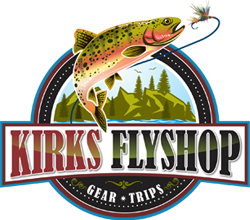Dry Flies vs. Wet Flies: What’s the Difference?
In the sport of fly fishing, there are about as many kinds of flies as there are fish and as a result, it can be tough to tell the difference between dry flies vs. wet flies. While we are the number #1 Estes Park fly shop and Colorado fly fishing guides, we are happy to share our expertise with you and give light to the subject of the difference between a dry fly vs. wet fly. To give you a brief introduction to Colorado fly fishing, we’re going to discuss the two types of flies used to catch while trout fishing in Colorado: Wet flies vs. dry flies.

Wet Flies
Wet flies are the best introductory fly to use when deciding whether to fish a dry fly vs. wet fly as they sink below the surface, mimicking a bug at the mercy of the river’s current or maybe a baitfish that a larger fish might want to eat. The variety of wet flies is vast and we would need to write an entire book on the subject of wet flies vs. dry flies to thoroughly explain the subject. But for simplicity, wet flies are subsurface flies that mimic a food source for the fish you are targeting.
The wet fly method is much more forgiving for beginners and requires less knowledge and finesse to result in a great catch. Wet fly hooks are heavier, are easier to cast, resulting in better performance in deeper water. When fish are in deeper water, they’re less likely to be scared off by a fly splashing on the surface of the water and are more likely to go after a wet fly vs. dry fly. The one downside to wet flies is that it can be difficult to tell if a fish has the fly as the current pulls on the line which there are many different tools we can use too solve this problem — strike indicators being the most prominent.

Dry Flies
Dry flies are flies that float on the surface of the water – typically, it imitates an adult insect but the line gets fuzzy when you start talking about poppers (basically dry streamers), mouse patterns, etc. For simplicity, we’ll talk about this as it pertains to trout fishing in Colorado. Typical dry flies include flies that imitate mayflies, stoneflies, caddis, midges, and terrestrials like grasshoppers, ants, and beetles. But the list of different kinds of dry flies is long and not limited to those mentioned.
Dry flies present more of a challenge for anglers and require a more experienced hand when casting. Because these flies rest on the top of the water, mimicking bugs landing on the surface, they have to hit the target perfectly and gently. Fish that are attracted to these flies are swimming close to the surface and are more easily scared off by a bad cast that disturbs the water. Dry fly fishing in Colorado requires a deep understanding of the types of bugs fish are attracted to, making it more of a challenge and ideal for more experienced anglers. However, because dry flies rest on the surface of the water, it can be easier to tell if a fish is going after the fly.
In the sport of fly fishing, whether you choose to use wet flies beneath the surface or work with dry flies on the water’s top, each cast is an exploration where nature and skill come together. As you cast your line and explore Estes Park fly fishing, may your decision between dry fly vs. wet fly be influenced by the flow of the river and the subtle signals from the trout below. Happy casting!
Have any questions about dry fly fishing fishing vs. wet fly fishing? Call our Estes Park fly shop! We’re happy to help steer you in the right direction on the best method of fly fishing — dry flies vs. wet flies.

